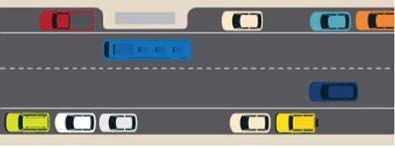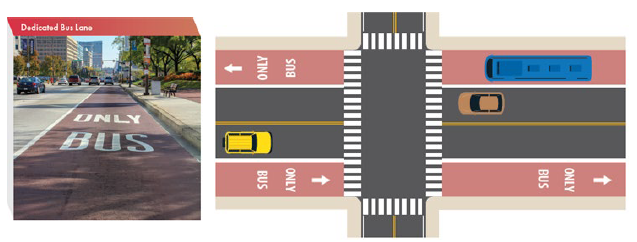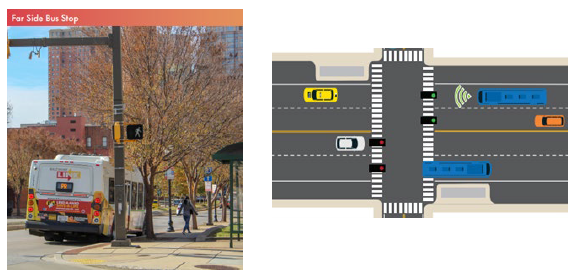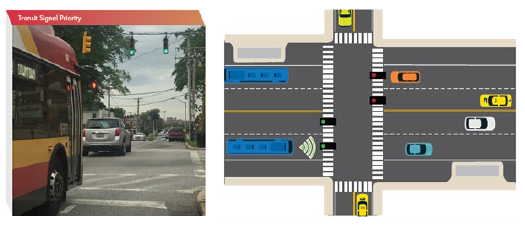FAQ's and Glossary
Project Details

The RAISE Project improves the reliability, speed, safety, and accessibility of transit by including the following elements:
- Dedicated Bus Lanes (DBLs), Bus Bulbs and a Queue Jump on select congested segments along the CityLink Blue & CityLink Orange bus routes (subject to change as the design advances):
- Full-time DBL along Edmondson Avenue from Cooks Lane to North Woodington Road and from North Hilton Street to North Rosedale StreetFull-time DBL along Edmondson Avenue from Cooks Lane to North Woodington Road and from North Hilton Street to North Rosedale Street
- Peak period DBL along Edmondson Avenue from North Woodington Road to North Hilton Street and from North Rosedale Street to North Longwood Street
- Full-time DBL along West Franklin Street from North Longwood Street to North Warwick Avenue
- Full-time DBL along Fayette Street from President Street to North Central Avenue (westbound only) (the queue jump is located within this segment)
- Bus bulbs from North Washington Street to North Highland Avenue
- Transit Signal Priority (TSP) at up to 60 traffic lights along the corridor to prioritize bus movements
- Bus stop upgrades at over 100 locations - ADA compliance, benches, trash cans, pedestrian lighting
- Signage upgrades at high-transfer activity ‘hubs’ - wayfinding and real-time arrival information
- Pedestrian & bicycle safety improvements - trees, lighting, curb extensions, sidewalks, new crosswalks
- Bicycle connection between Downtown Baltimore and West Baltimore MARC rail station

Project History
An east-west rapid transit corridor in Baltimore has been studied for over 50 years, and the route from east to west along the CityLink Orange and CityLink Blue alignments continues to have among the highest demand for highcapacity transit in the region. Various plans, listed below, have been developed for this project corridor:
The analyses and recommendations in these plans recognize the RAISE Project corridor as one of the highestpriority corridors in the Baltimore region.
Several “early opportunity” corridors were identified in the RTP as being suitable for near-term implementation. The RAISE Project corridor was one of only four corridors to meet all transit readiness conditions and was prioritized for near-term transit investments. While plans for this corridor have identified different modes and alignments over decades of planning, they have all consistently identified the need for additional transit investment to link to the following communities:
- Edmondson Village
- Midtown Edmondson
- Poppleton
- Westside
- Charles Center
- Highlandtown
- Bayview
Public Comment, Equity & Accessibility
On-going feedback is encouraged throughout the life of the RAISE Project. You may:
- Visit the project website at RAISEBaltimore.com to learn more about the project and upcoming public meetings, submit a comment form and view interactive web mapping
- Email the project team at info@RAISEBaltimore.com
- Join the project mailing list by sending a request to info@RAISEBaltimore.com or by completing a comment form.
You may provide comments via email to info@RAISEBaltimore.com or by completing a comment form. All comments received will be given equal consideration.
You may comment directly within interactive mapping developed for this project: RAISE Baltimore Transit Priority Project Comment Map
Featured within this map are the locations of existing CityLink Orange and CityLink Blue Line bus stops, pedestrian facilities, transit signal priority areas, and proposed and existing dedicated bus lanes.
Comments and concerns can be expressed using pushpin icons for the following categories:
- Bus Stop Amenities
- Bus Operations
- Traffic Congestion
- Pedestrian / Bicycle Facilities
- Americans with Disabilities Act (ADA)
If there’s a location where you’d like to comment, please add it to the map by following these steps:
- 1. Select an icon from the menu bar on the right
- 2. Click on the map where you want to add the feature
- 3. Fill in the pop-up with any additional comments that you may have
- 4. Click Save to finalize the addition
Title VI & Accessibility
If you have any questions or need assistance, please contact the MDOT MTA Transit Information Contact Center – 410-539-5000; 866-743-3682; TTY 410-539-3497; MD Relay users dial 7-1-1. Or, MDOT MTA Office of Equal Opportunity Compliance Programs (EOCP) -- ADA/Title VI Coordinator at (410) 767-3944, email address: MTAEqualAccess@mta.maryland.gov, or, Bart Plano at bplano@mta.maryland.gov.
Transit Basics
Dedicated bus lanes will be evaluated by their ability to improve the following metrics:
- Travel Time Reliability - The consistency of travel time from day to day and at various times of the day.
- Travel Delay - Anything which interferes with bus travel including traffic congestion, crashes, or operational failure. Travel delay is the main source of poor travel time reliability.
No. The RAISE Baltimore project’s purpose is to provide enhancements to the existing CityLink Blue and CityLink Orange bus routes; whereas a BRT project would include additional service, upgraded stations, dedicated guideway and the potential for new branded vehicles.
Median Running Dedicated Bus Lanes, which would function similar to a more complex Bus Rapid Transit (BRT) system, have been considered along segments of the RAISE corridor. Results show that this type of bus lane is not cost-effective, would incur greater impacts, would still require local bus service, and therefore will not be considered further for the RAISE Baltimore project.
The RAISE Baltimore project’s purpose is to provide enhancements to the existing CityLink Blue and CityLink Orange bus routes; however, MDOT MTA and local jurisdictions are currently researching cost estimates for other projects that could be implemented mid- and long-term along the East-West Corridor that include Light Rail Transit (LRT).
You can see proposed improvement locations by viewing mapping at the project website: RAISEBaltimore.com, attend an Open House, or talk with a project team member at a pop-up meeting along the RAISE corridor.
You may also request a virtual or in-person community meeting with the project team by sending an email to info@RAISEBaltimore.com or by submitting a comment on the project website Interactive Map.
Glossary
The Americans with Disabilities Act (ADA) of 1990 prohibits discrimination and ensures equal opportunity and access for persons with disabilities. This act works to ensure nondiscriminatory transportation in support of its mission to enhance the social and economic quality of life for all Americans.
Complete Streets - Complete Streets will be designed to address safety, be accessible, improve mobility, ensure equity, and reflect Baltimore’s unique communities, while prioritizing the movement of the streets’ most vulnerable users. Baltimore’s citywide modal hierarchy—recommended by the Complete Streets Advisory Committee and endorsed by BCDOT—is prioritized as:
- Walking
- Cycling / Public Transit / Micromobility
- Taxi / Commercial Transit / Shared Vehicles
- Single Occupant Automobiles
Photo: MDOT MTA Transit Priority Toolkit

Dedicated Bus Lanes (DBL) convert existing travel or parking lanes in each direction to a bus-only lane using striping, markings, red paint and signage. Red paint emphasizes that the lane is for transit only and deters drivers from using the lane, thus reducing the amount of time that buses are slowed by traffic congestion. DBLs would also allow safe shared use with bicycles.
Photo: MDOT MTA Transit Priority Toolkit

An Electric Vehicle (EV) Charging Station is a piece of equipment that supplies electrical power for charging plug-in electric vehicles (including hybrids, neighborhood electric vehicles, trucks, buses, and others).
Far Side Bus Stop - When a bus stop is placed on the far side of an intersection, the bus moves through the intersection then pulls over to the bus stop. Generally, “far side” bus stops are preferred since they’ve been shown to reduce stop time and increase safety for motorists, pedestrians, and cyclists.
Photo: MDOT MTA Transit Priority Toolkit

Real-time Information Signs (RTIS) are digital signs that display route destinations, frequencies, and estimated arrival times for buses, pulling data from several information technology systems to provide valuable information for bus riders. Buses in MDOT MTA’s system are equipped with GPS systems to report real-time data, which is shared through a mobile app and real-time signs at several transit hubs.
Transit-Oriented Development (TOD) is a type of urban development that maximizes the amount of residential, business and leisure space within walking distance of public transport. It promotes a symbiotic relationship between dense, compact urban form and public transport use.
Transit Signal Priority (TSP) is a technology that adjusts the traffic signal timing when transit vehicles are present to allow them to more quickly travel through the intersection. This technology can significantly reduce bus delay, which improves travel time and reliability for transit riders. MDOT MTA has implemented TSP at 66 intersections in the MDOT MTA system and a 2018 analysis showed that run times along certain segments implementing TSP dropped by as much as 20% during peak hours.
Photo: MDOT MTA Transit Priority Toolkit

